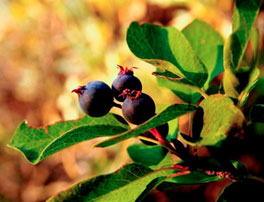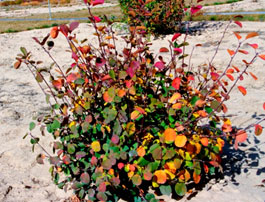Serviceberry in the Landscape


Stephen Love, University of Idaho
Scientfic Name: Amelanchier alnifolia, Amelanchier pumila, Amelanchier utahensisCommon Name: Serviceberry, Saskatoon Serviceberry, Juneberry
Description: Three species of serviceberry are common in the Intermountain West, Amelanchier alnifolia (Saskatoon serviceberry), Amelanchier utahensis (Utah serviceberry), and Amelanchier pumila (dwarf serviceberry). These species are similar and will be discussed as the same plant in this monograph. The Saskatoon serviceberry is widely grown for its berries. The dwarf serviceberry, with its compact form, has unexploited potential as a landscape plant. Serviceberries are small to moderately large, deciduous shrubs. The leaves are dark green, leathery, toothed at the tips, and turn spectacular shades of orange and red in the fall. The bushes produce numerous white flowers in early spring, followed by bluish-purple, edible berries in late summer. Pollinators, birds, and mammals all benefit from the presence of this species.
Native Habitat: Serviceberries have a large native range. Amelanchier alnifolia grows in the Upper Midwest and throughout the Mountain-west states. Amelanchier pumila is a western species and grows in all of the Intermountain and Pacific states except Nevada. Amelanchier utahensis grows in all mountain-west states plus Texas. Serviceberry inhabits a wide range of habitats, from riparian sites, to dry hillsides, to alpine heights. Inclusive elevation range for the three species is 5,000 to 10,000 feet.
Cultural Requirement
Soil: Tolerates any type of soil, including those with high pH, as long as the soil is not high in salts or frequently saturated.
Moisture Tolerance: Moderately drought tolerant, but requires some moisture during the summer months to remain attractive and produce high-quality berries.
Sun/Shade/Preference: Optimum berry production and best fall color occur in full sun but the plants will thrive in part shade.
Transplanting: Very easy to transplant with high rates of survival both from pot to pot and from pot to garden. Plants develop fairly rapidly, tolerate pot culture, and maintain acceptable appearance in pots up to 5-gallon size.
Propagation: Best propagated from seed. Seeds require cold-moist stratification for 3 to 4 months. It is important to inspect seeds occasionally in stratification and change the medium if fungal growth is present. Upon emergence, transplant seedlings into long liners or deep pots to encourage proper root development. Serviceberries have a reputation for being very difficult to propagate as rooted cuttings. Tissue culture can be used for rapid propagation.
Maintenance (pruning, fertilization, deadheading, division, irrigation, etc): Routine spring pruning is required to remove aging interior branches, control size, and improve form. Infrequent, but deep irrigation may be required to keep plants healthy and productive. Small amounts of nitrogen fertilizer added in the spring or fall helps keep plants vigorous.
Insect, disease, or other problems: Serviceberry is subject to a number of insect and disease problems. Most forms of the species are susceptible to fireblight and can be infected if planted near apple trees. Leaf spot diseases are common but seldom require control measures. Aphids and scales sometimes infest shrubs and may occasionally need to be controlled with dormant oils or insecticides.
Landscape Value
Use in the Landscape: Serviceberries can be employed in the same manner as any small to large flowering shrub. They can be effective as screens or used to fill out the understory of large trees. Tall forms look nice planted singly as a specimen or to occupy open space. Smaller forms are very effective permanent elements of mixed beds and borders. Open, tall forms are best used in naturalized plantings while small, compact forms can be used in formal landscape designs.
Weediness/Invasive Potential: Serviceberries are clump-forming or exhibit very short rhizomes that lack invasiveness. Volunteer seedling production is extremely limited. This complex of three species is not invasive.
Foliage: The foliage is deciduous. Leaves are small to medium in size, single, and toothed at the tip. New foliage often has a reddish color. Mature leaves are usually dark green or bluish-green. In the fall, the leaves turn bright orange or red.
Flower: Flowers appear in early spring, usually April or May. Bloom period is relative short, usually less than 3 weeks. Flowers consist of 5 long, narrow, brilliantly white petals. Flower production for most forms of serviceberry can be prodigious.
Timing: April-May
Fruit: Although referred to as a berry in this description, the fruit of serviceberry is actually not a berry but is rather a pome, much like a miniature apple. Color changes as the fruits ripen, shifting from green to light red, to dark purple or blue. Each pome contains several smooth, brown, kidney-shaped seeds.
Form: Upright to arching, eventually forming a rounded crown.
Texture: Medium to coarse.
Ultimate Size: Mature size is dependent on species and ecotype. Height and spread are relatively equal and can range from 3 to 15 feet.
Rate of Growth: In comparison with most shrubs, serviceberries grow fairly rapidly and can begin flowering and fruiting as early as the second (but more usually the third) year from seed. Ornamental impact in the landscape, as contributed by attractive foliage and brilliant fall color, is immediate.
Suggested Plant Partners: Serviceberry can be effectively used to fill spaces around deciduous and evergreen trees, such as Betula occidentalis, Celtis reticulata, Juniperus scopulorum, and Pinus flexilis. In a mixed border, good partners include Chamaebatiaria millefolium, Mahonia aquifolium, Ericameria nauseosa, Eriogonum corymbosum, Penstemon venustus, Iris missouriensis, and Zauschneria garrettii.
Availability: Edible Saskatoon cultivars are commonly available as potted plants from traditional and native-plant nurseries. The compact A. pumila and more drought tolerant A. utahensis are more difficult to find and obtainable only as seed from native-plant seed companies.
Cultivars: There are at least 26 named cultivars of Saskatoon serviceberries. ‘Altaglow’ is an older, tall cultivar with good fall color. Other cultivars easily found in the nursery trade include ‘Smokey’, ‘Martin’, ‘Pembina’, ‘Northline’, ‘Honeywood’, and ‘Thiessen’.
References:

